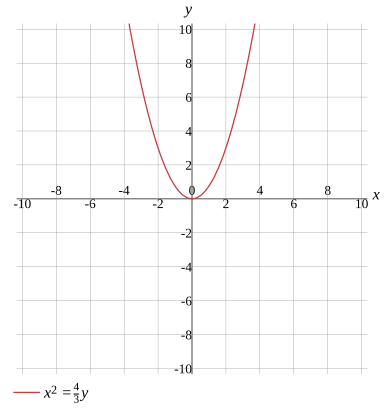Question
Function
Find the x-intercept/zero
Find the y-intercept
x=0
Evaluate
3x2−4y=0
To find the x-intercept,set y=0
3x2−4×0=0
Any expression multiplied by 0 equals 0
3x2−0=0
Removing 0 doesn't change the value,so remove it from the expression
3x2=0
Rewrite the expression
x2=0
Solution
x=0
Show Solution

Solve the equation
Solve for x
Solve for y
x=323yx=−323y
Evaluate
3x2−4y=0
Move the expression to the right-hand side and change its sign
3x2=0+4y
Add the terms
3x2=4y
Divide both sides
33x2=34y
Divide the numbers
x2=34y
Take the root of both sides of the equation and remember to use both positive and negative roots
x=±34y
Simplify the expression
More Steps


Evaluate
34y
To take a root of a fraction,take the root of the numerator and denominator separately
34y
Multiply by the Conjugate
3×34y×3
Calculate
34y×3
Calculate
More Steps


Evaluate
4y×3
The product of roots with the same index is equal to the root of the product
4y×3
Calculate the product
12y
Write the expression as a product where the root of one of the factors can be evaluated
4×3y
Write the number in exponential form with the base of 2
22×3y
The root of a product is equal to the product of the roots of each factor
22×3y
Reduce the index of the radical and exponent with 2
23y
323y
x=±323y
Solution
x=323yx=−323y
Show Solution

Testing for symmetry
Testing for symmetry about the origin
Testing for symmetry about the x-axis
Testing for symmetry about the y-axis
Not symmetry with respect to the origin
Evaluate
3x2−4y=0
To test if the graph of 3x2−4y=0 is symmetry with respect to the origin,substitute -x for x and -y for y
3(−x)2−4(−y)=0
Evaluate
More Steps


Evaluate
3(−x)2−4(−y)
Multiply the terms
3x2−4(−y)
Multiply the numbers
3x2−(−4y)
Rewrite the expression
3x2+4y
3x2+4y=0
Solution
Not symmetry with respect to the origin
Show Solution

Identify the conic
Find the standard equation of the parabola
Find the vertex of the parabola
Find the focus of the parabola
Load more

x2=34y
Evaluate
3x2−4y=0
Move the expression to the right-hand side and change its sign
3x2=0−(−4y)
If a negative sign or a subtraction symbol appears outside parentheses, remove the parentheses and change the sign of every term within the parentheses
3x2=0+4y
Removing 0 doesn't change the value,so remove it from the expression
3x2=4y
Multiply both sides of the equation by 31
3x2×31=4y×31
Multiply the terms
x2=4y×31
Solution
x2=34y
Show Solution

Rewrite the equation
r=0r=34sin(θ)sec2(θ)
Evaluate
3x2−4y=0
To convert the equation to polar coordinates,substitute x for rcos(θ) and y for rsin(θ)
3(cos(θ)×r)2−4sin(θ)×r=0
Factor the expression
3cos2(θ)×r2−4sin(θ)×r=0
Factor the expression
r(3cos2(θ)×r−4sin(θ))=0
When the product of factors equals 0,at least one factor is 0
r=03cos2(θ)×r−4sin(θ)=0
Solution
More Steps


Factor the expression
3cos2(θ)×r−4sin(θ)=0
Subtract the terms
3cos2(θ)×r−4sin(θ)−(−4sin(θ))=0−(−4sin(θ))
Evaluate
3cos2(θ)×r=4sin(θ)
Divide the terms
r=3cos2(θ)4sin(θ)
Simplify the expression
r=34sin(θ)sec2(θ)
r=0r=34sin(θ)sec2(θ)
Show Solution

Find the first derivative
Find the derivative with respect to x
Find the derivative with respect to y
dxdy=23x
Calculate
3x2−4y=0
Take the derivative of both sides
dxd(3x2−4y)=dxd(0)
Calculate the derivative
More Steps


Evaluate
dxd(3x2−4y)
Use differentiation rules
dxd(3x2)+dxd(−4y)
Evaluate the derivative
More Steps


Evaluate
dxd(3x2)
Use differentiation rule dxd(cf(x))=c×dxd(f(x))
3×dxd(x2)
Use dxdxn=nxn−1 to find derivative
3×2x
Multiply the terms
6x
6x+dxd(−4y)
Evaluate the derivative
More Steps


Evaluate
dxd(−4y)
Use differentiation rules
dyd(−4y)×dxdy
Evaluate the derivative
−4dxdy
6x−4dxdy
6x−4dxdy=dxd(0)
Calculate the derivative
6x−4dxdy=0
Move the expression to the right-hand side and change its sign
−4dxdy=0−6x
Removing 0 doesn't change the value,so remove it from the expression
−4dxdy=−6x
Change the signs on both sides of the equation
4dxdy=6x
Divide both sides
44dxdy=46x
Divide the numbers
dxdy=46x
Solution
dxdy=23x
Show Solution

Find the second derivative
Find the second derivative with respect to x
Find the second derivative with respect to y
dx2d2y=23
Calculate
3x2−4y=0
Take the derivative of both sides
dxd(3x2−4y)=dxd(0)
Calculate the derivative
More Steps


Evaluate
dxd(3x2−4y)
Use differentiation rules
dxd(3x2)+dxd(−4y)
Evaluate the derivative
More Steps


Evaluate
dxd(3x2)
Use differentiation rule dxd(cf(x))=c×dxd(f(x))
3×dxd(x2)
Use dxdxn=nxn−1 to find derivative
3×2x
Multiply the terms
6x
6x+dxd(−4y)
Evaluate the derivative
More Steps


Evaluate
dxd(−4y)
Use differentiation rules
dyd(−4y)×dxdy
Evaluate the derivative
−4dxdy
6x−4dxdy
6x−4dxdy=dxd(0)
Calculate the derivative
6x−4dxdy=0
Move the expression to the right-hand side and change its sign
−4dxdy=0−6x
Removing 0 doesn't change the value,so remove it from the expression
−4dxdy=−6x
Change the signs on both sides of the equation
4dxdy=6x
Divide both sides
44dxdy=46x
Divide the numbers
dxdy=46x
Cancel out the common factor 2
dxdy=23x
Take the derivative of both sides
dxd(dxdy)=dxd(23x)
Calculate the derivative
dx2d2y=dxd(23x)
Rewrite the expression
dx2d2y=2dxd(3x)
Solution
More Steps


Evaluate
dxd(3x)
Simplify
3×dxd(x)
Rewrite the expression
3×1
Any expression multiplied by 1 remains the same
3
dx2d2y=23
Show Solution

Graph
